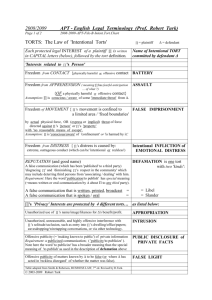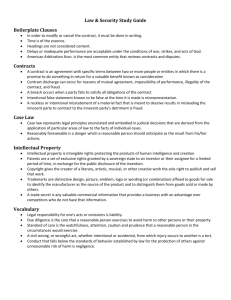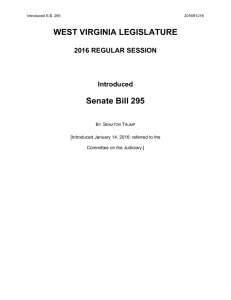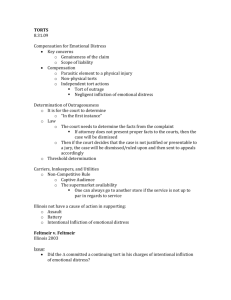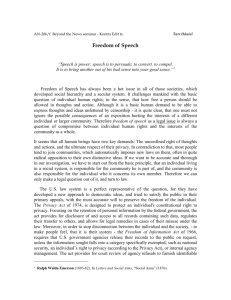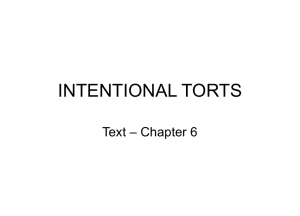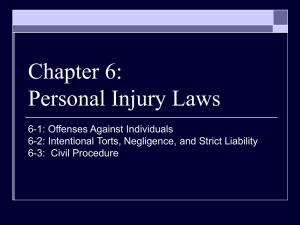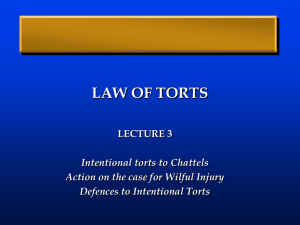Intentional Torts Chapter 15 When someone intentionally injuries a
advertisement
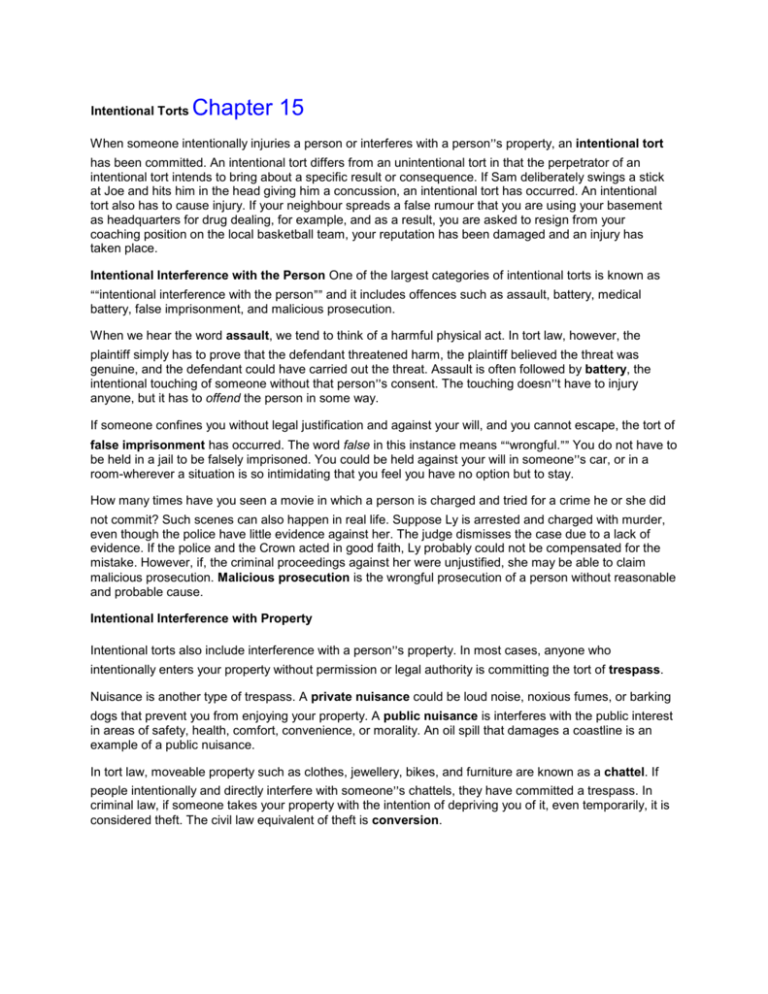
Intentional Torts Chapter 15 When someone intentionally injuries a person or interferes with a person==s property, an intentional tort has been committed. An intentional tort differs from an unintentional tort in that the perpetrator of an intentional tort intends to bring about a specific result or consequence. If Sam deliberately swings a stick at Joe and hits him in the head giving him a concussion, an intentional tort has occurred. An intentional tort also has to cause injury. If your neighbour spreads a false rumour that you are using your basement as headquarters for drug dealing, for example, and as a result, you are asked to resign from your coaching position on the local basketball team, your reputation has been damaged and an injury has taken place. Intentional Interference with the Person One of the largest categories of intentional torts is known as AAintentional interference with the person@@ and it includes offences such as assault, battery, medical battery, false imprisonment, and malicious prosecution. When we hear the word assault, we tend to think of a harmful physical act. In tort law, however, the plaintiff simply has to prove that the defendant threatened harm, the plaintiff believed the threat was genuine, and the defendant could have carried out the threat. Assault is often followed by battery, the intentional touching of someone without that person==s consent. The touching doesn==t have to injury anyone, but it has to offend the person in some way. If someone confines you without legal justification and against your will, and you cannot escape, the tort of false imprisonment has occurred. The word false in this instance means AAwrongful.@@ You do not have to be held in a jail to be falsely imprisoned. You could be held against your will in someone==s car, or in a room-wherever a situation is so intimidating that you feel you have no option but to stay. How many times have you seen a movie in which a person is charged and tried for a crime he or she did not commit? Such scenes can also happen in real life. Suppose Ly is arrested and charged with murder, even though the police have little evidence against her. The judge dismisses the case due to a lack of evidence. If the police and the Crown acted in good faith, Ly probably could not be compensated for the mistake. However, if, the criminal proceedings against her were unjustified, she may be able to claim malicious prosecution. Malicious prosecution is the wrongful prosecution of a person without reasonable and probable cause. Intentional Interference with Property Intentional torts also include interference with a person==s property. In most cases, anyone who intentionally enters your property without permission or legal authority is committing the tort of trespass. Nuisance is another type of trespass. A private nuisance could be loud noise, noxious fumes, or barking dogs that prevent you from enjoying your property. A public nuisance is interferes with the public interest in areas of safety, health, comfort, convenience, or morality. An oil spill that damages a coastline is an example of a public nuisance. In tort law, moveable property such as clothes, jewellery, bikes, and furniture are known as a chattel. If people intentionally and directly interfere with someone==s chattels, they have committed a trespass. In criminal law, if someone takes your property with the intention of depriving you of it, even temporarily, it is considered theft. The civil law equivalent of theft is conversion. Defences for Interference with the Person or Property The defendant being sued for an intentional tort has a variety of available defences. One defence is consent. If someone voluntarily agrees to a specific physical contact, that person cannot argue that you committed an intentional tort unless your actions went beyond the contact that was consented to. The defence of consent can also be used in the tort of AAtrespass to property.@@ If your neighbour gives you permission to be on her property, then sues you for trespassing, she would likely be unsuccessful unless you damaged the property or abuse the purpose for which you were allowed to enter the premises. Another defence is self-defence, using reasonable force to protect yourself against physical attack or a threat of violence. People are also allowed to use force in the defence of a third party, if they believe at the time that someone else is in immediate danger. Defamation of Character We have all seen headlines in tabloids or magazines that sensationalize the lives of celebrities or make damaging statements about someone==s life? If the accusations are unfounded and cause injury to a person==s fame, reputation, or character, these media can be sued for defamation. Defamation is generally divided into two categories-slander and libel. Slander is the oral statement or gesture that damages a person==s reputation. Libel is defamation in a permanent form, such as statements that are written, printed, recorded, or filmed, or depictions, such as cartoons, drawings, or carvings. Defences to Defamation The strongest defence to slander or libel is truth. A plaintiff who sues for defamation will not succeed if the defendant can prove that the statements are true. Fair comment is another defence used by critics or reviewers are expressing a personal opinion based on fact regarding a matter of public interest. Politicians and other state officers also have a defence known as absolute privilege, which allows them to speak openly about a others without fear of legal actions. The statements must be made in Parliament, provincial legislatures, or court. Questions: Worksheets: p.391: 1-3 p.393:1,2 (to be answered in class) p.395:1,2 (to be answered in class) p.398:1-3 p.401:1-3 p.407:1,2 p.408:1-4,6,7 p.409-410:1-3,5,7,8,10 BLM 15-1 Assignments:

